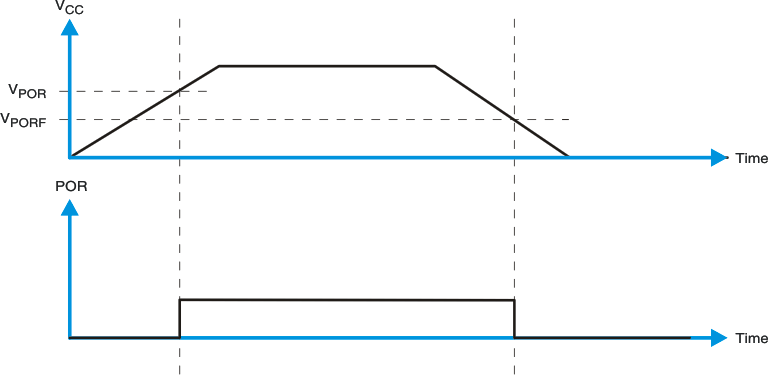JAJSVD6K July 2001 – September 2024 PCF8574
PRODUCTION DATA
- 1
- 1 特長
- 2 アプリケーション
- 3 概要
- 4 Pin Configuration and Functions
- 5 Specifications
- 6 Parameter Measurement Information
- 7 Detailed Description
- 8 Application and Implementation
- 9 Device and Documentation Support
- 10Revision History
- 11Mechanical, Packaging, and Orderable Information
8.3.1 Power-On Reset Requirements
In the event of a glitch or data corruption, the PCF8574 device can be reset to its default conditions by using the power-on reset feature. Power-on reset requires that the device go through a power cycle to be completely reset. This reset also happens when the device is powered on for the first time in an application.
The two types of power-on reset are shown in Figure 8-6 and Figure 8-7.
 Figure 8-6 VCC is Lowered Below 0.2 V or 0 V and Then Ramped Up to VCC
Figure 8-6 VCC is Lowered Below 0.2 V or 0 V and Then Ramped Up to VCC Figure 8-7 VCC is Lowered Below the POR Threshold, Then Ramped Back Up to VCC
Figure 8-7 VCC is Lowered Below the POR Threshold, Then Ramped Back Up to VCCTable 8-1 specifies the performance of the power-on reset feature for PCF8574 for both types of power-on reset.
| PARAMETER | MIN | TYP | MAX | UNIT | ||
|---|---|---|---|---|---|---|
| VCC_FT | Fall rate | See Figure 8-6 | 1 | 100 | ms | |
| VCC_RT | Rise rate | See Figure 8-6 | 0.01 | 100 | ms | |
| VCC_TRR_GND | Time to re-ramp (when VCC drops to GND) | See Figure 8-6 | 0.001 | ms | ||
| VCC_TRR_POR50 | Time to re-ramp (when VCC drops to VPOR_MIN – 50 mV) | See Figure 8-7 | 0.001 | ms | ||
| VCC_GH | Level that VCCP can glitch down to, but not cause a functional disruption when VCCX_GW = 1 μs | See Figure 8-8 | 1.2 | V | ||
| VCC_GW | Glitch width that will not cause a functional disruption when VCCX_GH = 0.5 × VCCx | See Figure 8-8 | μs | |||
| VPORF | Voltage trip point of POR on falling VCC | 0.99 | 1.28 | V | ||
| VPORR | Voltage trip point of POR on fising VCC | 1.190 | 1.410 | V | ||
Glitches in the power supply can also affect the power-on reset performance of this device. The glitch width (VCC_GW) and height (VCC_GH) are dependent on each other. The bypass capacitance, source impedance, and device impedance are factors that affect power-on reset performance. Figure 8-8 and Table 8-1 provide more information on how to measure these specifications.
 Figure 8-8 Glitch Width and Glitch Height
Figure 8-8 Glitch Width and Glitch HeightVPOR is critical to the power-on reset. VPOR is the voltage level at which the reset condition is released and all the registers and the I2C/SMBus state machine are initialized to their default states. The value of VPOR differs based on the VCC being lowered to or from 0. Figure 8-9 and Table 8-1 provide more details on this specification.
 Figure 8-9 VPOR
Figure 8-9 VPOR